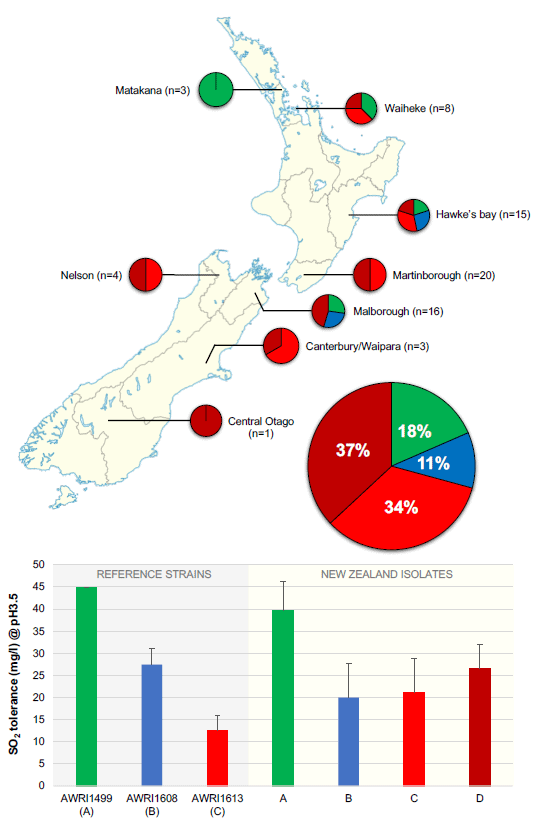What’s that smell – a look into Brett
Brettanomyces yeasts, responsible for the distinct blend of ‘phenolic, ‘barnyard’ and ‘medicinal’ aromas known as ‘Brett’ character, are an endemic presence in wine regions around the world. A focus of research in many regions has been to determine whether the perennial challenge of avoiding wine spoilage is linked to genetic variation amongst these yeasts. In other words, is the efficacy of ‘Brett’ control strategies affected by the strains present in a given winery or region? Previous work in Australia demonstrated that the most prevalent strain was able to tolerate more sulfite. Wineries with this strain present needed to apply sulfite more effectively in order to keep this strain under control.

Until now there has been no information available regarding the Brettanomyces population in New Zealand. Collaborative research led by Prof. Mat Goddard (University of Auckland) in partnership with Asst. Prof. Chris Curtin (Oregon State University) has made use of the power of genomic sequencing to determine whether Brettanomyces strains in New Zealand wine regions are similar to those observed elsewhere in the world.
Three major reference strains (AWRI1499, AWRI1608 and AWRI1613) known for their differences in sulfite tolerance have distinct genomic signatures. In Australia these strains represent 98% of observed isolates from 31 winemaking regions (Curtin et al. 2007), and perhaps more importantly, 85% belonged to group A which displayed the greatest tolerance to sulfite. Of the 70 New Zealand isolates for which useable sequence data was obtained, only 18% correspond to this genetic grouping, while a sizeable portion (37%) belonged to a group that may not have been observed in Australia. Sulfite tolerances of the NZ isolates belonging to the four strain groupings was in line with previous observations. Taken together this means that NZ wine regions do harbor sulfite-tolerant Brettanomyces strains, but these are found at relatively low frequency compared with Australia and may not be present in all regions. Importantly, no isolates were recovered that exhibited sulfite “super-tolerance”.
Why is the strain distribution different in NZ? Current winemaking practices and wine composition may favour strains that have different capabilities allowing their proliferation in wine, aside from tolerance to sulfite. Ongoing work in the project is seeking to identify these factors, and to evaluate the relative capacity of the different NZ Brettanomyces strains to spoil wine, with emphasis on Pinot Noir.
What does this mean for winemakers? In wineries/regions were strain group A has been observed great care should be taken to ensure sufficient levels of free molecular SO2 to control Brettanomyces (>0.6mg/L, ideally >0.8mg/L). In wineries where lower molecular SO2 levels are typically achieved, but to date there have been no issues with ‘Brett’ spoilage, it is possible that this strain has not yet been introduced. Vigilance and careful screening of incoming wine and barrels would be advisable.
What does the future hold? This dataset provides baseline knowledge of Brettanomyces in NZ. As an industry, adoption of alternative ‘Brett’ control strategies that reduce reliance upon SO2, such as the application of fungal chitosan products, may alleviate selective pressure on the current Brettanomyces population and limit the spread of strain group A. Ideally, a repeat effort to gather new isolates and evaluate the population structure of Brettanomyces should be performed to ensure control strategies remain effective and winemakers can confidently produce ‘Brett’-free wine.
This article first appeared in the October / November 2018 issue of the New Zealand Winegrower magazine.

















